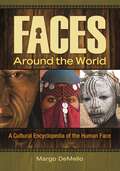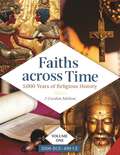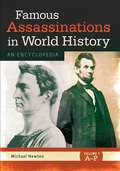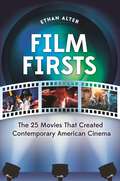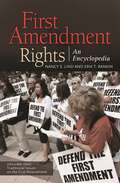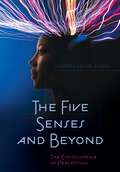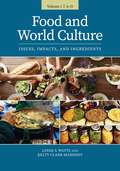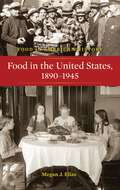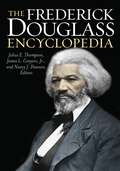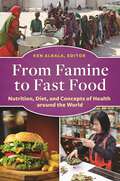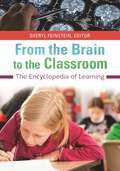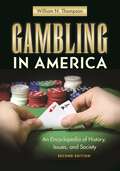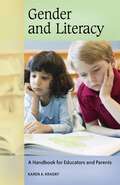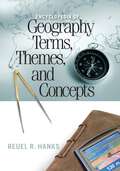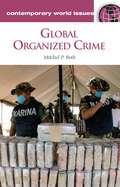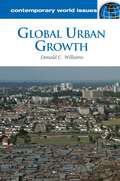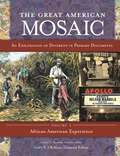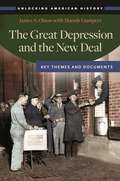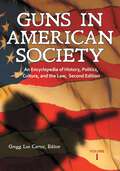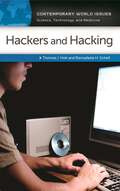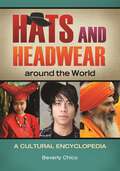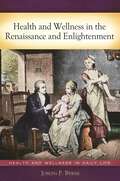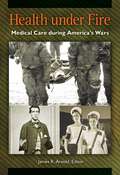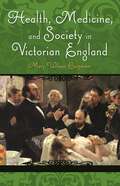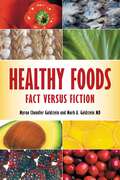- Table View
- List View
Faces around the World: A Cultural Encyclopedia of the Human Face
by Margo DeMelloThis book provides a comprehensive examination of the human face, providing fascinating information from biological, cultural, and social perspectives.Our faces identify who we are—not only what we look like and what ethnicities we belong to, but they can also identify what religions we practice and what personal ideologies we have. This one-of-a-kind A–Z reference explores the ways we change, beautify, and adorn our faces to create our personalities and identities.In addition to covering the basics such as the anatomical structure and function of parts of the human face, the entries examine how the face is viewed around the world, allowing students to easily draw connections and differences between various cultures around the world. Readers will learn about a wide variety of topics, including identity in different cultures; religious beliefs; folklore; extreme beautification; the "evil eye;" scarification; facial piercing and facial tattooing masks; social views about beauty including cosmetic surgery and makeup; how gender, class and sexuality play a role in our understanding of the face; and skin, eye, mouth, nose, and ear diseases and disorders. This encyclopedia is ideal for high school and undergraduate students studying anthropology, anatomy, gender, religion, and world cultures.
Faiths across Time [4 volumes]: 5,000 Years of Religious History [4 volumes]
by J. Gordon MeltonThis monumental, four-volume reference overviews significant events and developments in religious history over the course of more than five millennia.Written for high school students, undergraduates, and general readers interested in the history of world religions, this massive reference chronicles developments in religious history from 3500 BCE through the 21st century. The set comprises four volumes, treating the ancient world from 3500 BCE through 499 CE, 500 through 1399, 1400 through 1849, and 1850 through 2009. Each volume includes hundreds of brief entries, arranged chronologically and then further organized by region and religion. The entries provide fundamental information on topics ranging from the neolithic Ggantija temples near Malta through the election of Mary Douglas Glasspool as bishop of the Episcopal Diocese of Los Angeles in 2009. Global in scope and encyclopedic in breadth, this chronology of world religions is an essential purchase for all libraries concerned with the development of human civilization.
Famous Assassinations in World History [2 volumes]: An Encyclopedia [2 volumes]
by Michael NewtonRepresenting a unique reference tool for readers interested in history, criminology, or terrorism, this book provides the most complete and up-to-date coverage of assassinations of key figures throughout history and around the world.Effecting the death of a political figure, a leader of a nation, or a public figure usually captures people's attention. But how often is assassination effective to achieve the larger objective beyond the death of the targeted individual? Famous Assassinations in World History: An Encyclopedia offers more than 200 entries on assassinations of all kinds that will allow readers to grasp the often-complex motivating factors behind each event and better understand historical and contemporary social unrest.Each entry identifies the assassination target and summarizes that person's significance; discusses the person's assassination, including the factors that led up to it and its political and cultural contexts; and explains the powerful effects of the assassination in world history. The encyclopedia also includes various sidebars that spotlight relevant individuals, groups, and movements and present intriguing factoids such as the final disposition of notorious assassins' weapons and various films and novels that were inspired by famous assassinations. In addition, 23 primary source documents provide accounts of assassinations throughout world history.
Film Firsts: The 25 Movies That Created Contemporary American Cinema
by Ethan AlterThis forward-looking exploration of contemporary American film across the last 40 years identifies and examines the specific movies that changed the film industry and shaped its present and future.Since the mid-1970s, American cinema has gone through enormous changes, such as the birth of the modern summer blockbuster, the rise of the independent film industry, ongoing technological advancements in special effects, and the ever-evolving models for film distribution. Written by a professional film critic and film buff, this book tells the story of contemporary American cinema in a unique and engaging way: by examining 25 key movies that demonstrated a significant creative, technological, or business innovation that impacted the industry at large.Each chapter in this chronological survey of contemporary film is divided into two sections: "The Film," which offers a critical overview of the film in question; and "The First," which describes the specific innovation achieved by that film and places that achievement in the larger historical context. Two additional appendices in each chapter explore other significant aspects of both the film and its groundbreaking nature. The broad coverage—ranging from action movies to horror films to science fiction favorites—ensures the work's appeal to all film fans.
First Amendment Rights [2 volumes]: An Encyclopedia [2 volumes]
by Nancy S. Lind Erik T. RankinThis two-volume work addresses every key, cutting-edge issue regarding the First Amendment, including subjects such as freedom of religion, freedom of press, freedom of speech, and freedom of organization. First Amendment Rights: An Encyclopedia provides both historical information and current, 21st-century topics in First Amendment issues. Volume 1 addresses the subject through the lens of past decisions and precedent, updated to include controversies between new social media and civil liberties. Volume 2 examines the current state of First Amendment rights, addressing the changes in interpretations of the First Amendment by the Roberts Court as well as in-vogue issues such as Occupy Movements as well as student rights and responsibilities in freedom of religion and speech cases. Key cases are highlighted throughout the text to further comprehension of the underlying issues and subtle complexities.The information is presented so that readers can examine cases in the Roberts court and draw their own conclusions. Coverage is also provided of the challenges and opportunities that arise with the adoption of new technologies and their impact on the interpretations of the First Amendment.
The Five Senses and Beyond: The Encyclopedia of Perception
by Jennifer L. Hellier, EditorHow do our human senses work and help us interact with our surroundings, and what happens when these senses malfunction or are impaired? This book provides in-depth information that answers these questions and more.The Five Senses and Beyond: The Encyclopedia of Perception supplies students and general readers with accurate, up-to-date information about the human senses. It explains the "big five" senses in detail as well as lesser-known but important senses—perceptions such as balance, kinesthesia, temperature, and pain. After a helpful introduction, this reference work provides A-to-Z, cross-referenced entries on hundreds of topics in the realm of human perception that allow students to find and digest information quickly and draw connections between related topics. Through the use of activity sidebars, readers will also be able to explore the workings of the senses firsthand, lending an element of interactivity to this accessible encyclopedia. A convenient end-of-volume glossary provides definitions of unfamiliar terms.
Food and World Culture [2 volumes]: Issues, Impacts, and Ingredients [2 volumes]
by Linda S. Watts Kelty Clark-MahoneyThis book uses food as a lens through which to explore important matters of society and culture. In exploring why and how people eat around the globe, the text focuses on issues of health, conflict, struggle, contest, inequality, and power.Whether because of its necessity, pleasure, or ubiquity, the world of food (and its lore) proves endlessly fascinating to most people. The story of food is a narrative filled with both human striving and human suffering. However, many of today's diners are only dimly aware of the human price exacted for that comforting distance from the lived-world realities of food justice struggles. With attention to food issues ranging from local farming practices to global supply chains, this book examines how food&’s history and geography remain inextricably linked to sociopolitical experiences of trauma connected with globalization, such as colonization, conquest, enslavement, and oppression.The main text is structured alphabetically around a set of 70 ingredients, from almonds to yeast. Each ingredient's story is accompanied by recipes. Along with the food profiles, the encyclopedia features sidebars. These are short discussions of topics of interest related to food, including automats, diners, victory gardens, and food at world&’s fairs. This project also brings a social justice perspective to its content—weighing debates concerning food access, equity, insecurity, and politics.
Food in the United States, 1890-1945 (Food in American History)
by Megan J. EliasNo American history or food collection is complete without this lively insight into the radical changes in daily life from the Gilded Age to World War II, as reflected in foodways.From the Gilded Age to the end of World War II, what, where, when, and how Americans ate all changed radically. Migration to urban areas took people away from their personal connection to food sources. Immigration, primarily from Europe, and political influence of the Caribbean, Latin America, and the Pacific brought us new ingredients, cuisines, and foodways. Technological breakthroughs engendered the widespread availability of refrigeration, as well as faster cooking times. The invention of the automobile augured the introduction of "road food," and the growth of commercial transportation meant that a wider assortment of foods was available year round. Major food crises occurred during the Depression and two world wars. Food in the United States, 1890-1945 documents these changes, taking students and general readers through the period to explain what our foodways say about our society. This intriguing narrative is enlivened with numerous period anecdotes that bring America history alive through food history.
The Frederick Douglass Encyclopedia
by Julius E. Thompson, James L. Conyers, Jr., and Nancy J. DawsonA new cornerstone reference for students, scholars, and general readers, on Frederick Douglass—his life, writings, speeches, political views, and legacy.Like no other reference before it, The Frederick Douglass Encyclopedia celebrates and investigates the life, writings, and activism of one of the most influential African Americans in U.S. history.The Frederick Douglass Encyclopedia offers more than 100 alphabetically organized entries covering Douglass's extraordinary journey from childhood in bondage to forceful spokesperson for equality and freedom before, during, and after the Civil War. In addition to biographical details, the book looks at the full breadth of Douglass's writings and speeches, as well as the events that shaped his intellect and political views. Together, these entries create an enduring portrait of one of the nation's most iconic figures, a man who went from slavery to invited guest in Abraham Lincoln's White House, whose commitment to freedom for all led to his participation in the first women's rights conference at Seneca Falls, and whose profound influence ranged well beyond the borders of the United States.
From Famine to Fast Food: Nutrition, Diet, and Concepts of Health around the World
by Ken Albala Julia Abramson M. Shahrim Al-Karim E. N. Anderson Laura P. Appell-Warren Heather Arndt-Anderson Michael Ashkenazi Babette Audant Gabriela Villagran Backman Carolyn Bánfalvi Peter Barrett Cynthia D. Bertelsen Megan K. Blake Andrea Broomfield Cynthia Clampitt Neil L. Coletta Paul Crask Christine Crawford-Oppenheimer Anita Verna Liza Debevec Jonathan Deutsch Deborah Duchon Nathalie Dupree Pamela Elder Rachel Finn Richard Foss Nancy G. Freeman Ramin Ganeshram Hanna Garth Mary Gee Che Ann Abdul Ghani Maja Godina-Golija Annie Goldberg Darra Goldstein Keiko Goto Carla Guerrón Montero Mary Gunderson Liora Gvion Cherie Y. Hamilton Jessica B. Harris Melanie Haupt Ursula Heinzelmann Jennifer Hostetter Kelila Jaffe Zilkia Janer Brelyn Johnson Kate Johnston Desiree Koh Bruce Kraig R. J. Krajewski Erin Laverty Robert A. Leonard Jane Levi Yrsa Lindqvist William G. Lockwood Yvonne R. Lockwood Janet Long-Solís Kristina Lupp Máirtín Mac Con Iomaire Glenn R. Mack Andrea Macrae Giorgos Maltezakis Bertie Mandelblatt Marty Martindale Laura Mason Anton Masterovoy Anne Engammare Mcbride Michael R. Mcdonald Naomi M. Mcpherson Katrina Meynink Barbara J. Michael Diana Mincyte Rebecca Moore Nawal Nasrallah Henry Notaker Kelly O’ Leary Fabio Parasecoli Susan Ji-Young Park Rosemary Parkinson Charles Perry Irina Petrosian Suzanne Piscopo Theresa Preston-Werner Meg Ragland Carol Selva Rajah Birgit Ricquier Amy Riolo Owen Roberts Fiona Ross Signe Rousseau Kathleen Ryan Helen Saberi Cari Sánchez Peter Scholliers Colleen Taylor Roger Serunyigo Dorette Snover Celia Sorhaindo Lyra Spang Lois Stanford Aliza Stark Maria "Ging" Gutierrez Steinberg Anita Stewart Emily Stone Asele Surina Aylin Öney Tan Nicole Tarulevicz Karen Lau Taylor Thy Tran Leena Trivedi-Grenier Karin Vaneker Penny Van Esterik Richard Wilk Chelsie Yount Marcia ZoladzThe foods eaten by a nation's population play a key role in shaping the health of that society. This book presents country-specific information on how diet, food security, and concepts of health critically impact the well-being of the world's population.A country's food culture and eating habits directly impact the health and well-being of its citizens. Economic factors contribute to problems such as obesity and malnourishment. This book examines how diet affects health in countries around the world, discussing how the availability of food and the types of foods eaten influence numerous health factors and are tied to the prevalence of "lifestyle" diseases. Readers will discover the importance of diet and food culture in determining human health as well as make connections and notice larger trends within multicultural, international contexts.An ideal aid for high school and college students in completing research and writing assignments, this book supplies detailed diet- and health-related information about most major countries and regions in a single source. Each country profile will also include a convenient fact box with statistical information such as life expectancy, average caloric intake, and other health indicators.
From the Brain to the Classroom: The Encyclopedia of Learning
by Sheryl FeinsteinSupplying a foundation for understanding the development of the brain and the learning process, this text examines the physical and environmental factors that influence how we acquire and retain information throughout our lives. The book also lays out practical strategies that educators can take directly into the classroom.Comprising more than 100 entries, From the Brain to the Classroom: The Encyclopedia of Learning gathers experts in the fields of education, neuroscience, and psychology to examine how specific areas of the brain work in thought processes, and identifies how educators can apply what neuroscience has discovered to refine their teaching and instructional techniques. The wide range of subjects—organized within the main categories of student characteristics, classroom instructional topics, and learning challenges—include at-risk behaviors; cognitive neuroscience; autism; the lifespan of the brain, from prenatal brain development to the aging brain; technology-based learning tools; and addiction. Any reader who is interested in learning about how the brain works and how it relates to everyday life will find this work fascinating, while educators will find this book particularly helpful in validating or improving their teaching methods to increase academic achievement.
Gambling in America: An Encyclopedia of History, Issues, and Society
by William N. ThompsonThis one-volume reference provides a comprehensive overview of gambling in the Americas, examining the history, morality, market growth, and economics of the gaming industry.This is the most complete encyclopedia of gambling, covering the industry in great detail including the players, the games, the venues, and the surrounding social issues. Updates in this second edition reveal the impact of technological advances on the games, the growing legislation regulating the industry, and the expanding global footprint of gambling across the world—from Manitoba to Montana.Author William N. Thompson postulates on the impact of gambling on local communities and shows how the U.S. gaming industry is tied to the global market, most notably gaming expansion in Macau and Singapore. The book addresses the various forms of gaming, such as casino-based and online gambling, sports betting, and lotteries. Additional content examines the social issue of problem and pathological gambling and addresses the rehabilitation programs available for the mitigation and treatment of gambling problems.
Gender and Literacy: A Handbook for Educators and Parents (Handbooks for Educators and Parents)
by Karen A. KrasnyThis work offers parents, educators, and librarians a practical guide to discovering the ways gender identities are constructed through literacy practices, providing recommendations for addressing gender inequities in schools and in the community at large.Gender and Literacy: A Handbook for Educators and Parents focuses on issues related to the gendered experience of students from pre-kindergarten through grade 12, promoting an understanding that the issues surrounding gender cannot be reduced to broad generalizations. Author Karen A. Krasny seeks to make clear the complex notion of gender construction within the context of redefining what constitutes legitimate literacy practices in schools.This handbook will help to guide educators, parents, and librarians by assisting them in the selection and evaluation of print and media resources. The first chapter explains the need to understand the complex relationship between gender and literacy. The bulk of the book provides readers with a critical review of the studies conducted to investigate gendered literacy practices, while the last three chapters focus on actionable strategies and policy making.
Encyclopedia of Geography Terms, Themes, and Concepts
by Reuel R. HanksThis text provides an essential reference handbook for students of geography and related social sciences.How did the Greek geographer Eratosthenes make an accurate calculation of the earth's circumstance more than 1,500 years before the first voyage of Columbus to the New World? What are the "green belts" of England that dominate its rural landscape? And what is regarded as the driest continent on the planet?This handbook offers a broad coverage of terminology and concepts, serving as both an encyclopedic dictionary of geography terms and an approachable overview to the human and physical aspects of world geography. Approximately 150 geographic terms and concepts are defined and discussed, providing an accessible reference for anyone who requires a deeper knowledge of the language and ideas that are important to geography as a discipline. Helpful sidebars are provided to shed light on unusual or controversial theories and concepts. All major geographic concepts and terms are addressed and comprehensively explained using examples.
Global Organized Crime: A Reference Handbook (Contemporary World Issues)
by Mitchel P. RothThis book offers a comprehensive, multidimensional look into the major activities, groups, causes, and policing strategies related to global organized crime.Global Organized Crime: A Reference Handbook examines global organized crime dating back to its 17th-century roots. Unlike most works on the subject, which take a parochial approach by concentrating on individual countries or regions, this book uniquely details the impact of 21st-century globalization on such groups and their activities.Exploring the continuum of international organized crime and related developments from its early beginnings to the present era, the book also looks at the complicated issues that continue to influence its growth. It covers the impact of the end of the Cold War, immigration, the global drug trade, weapons sales, human smuggling and trafficking, the convergence of funding sources, and the effects of technology. What especially distinguishes this book is the connections it makes between organized crime activities and failed states, civil wars, political transitions, regional conflicts, and terrorist groups.
Global Urban Growth: A Reference Handbook (Contemporary World Issues)
by Donald C. Ph.D.This book examines the rapid expansion of urban areas worldwide, especially within the previous 50 years, identifying the factors that have contributed to this phenomenon and exploring its many consequences.Global Urban Growth: A Reference Handbook examines urbanization and the challenges associated with rapid urban growth and urban sprawl from a truly global perspective, rather than presenting only a limited exploration of the subject by addressing a single city, country, or region. Investigating urbanization and related policy challenges as both a general phenomenon of all modern societies and one that varies greatly in different regions of the world, the book charts different growth trajectories in these societies and varying policy responses. Significant variations in culture, historical background, economic factors, and political and social development are considered. A chapter on the United States and Canada documents how urbanization trends have occurred in North America and presents our policy approaches in comparison and contrast with the rest of the world. The author offers a balanced overview by marshaling the facts and clearly presenting both the benefits and the drawbacks for readers.
The Great American Mosaic [4 volumes]: An Exploration of Diversity in Primary Documents [4 volumes]
by Gary Y. OkihiroFirsthand sources are brought together to illuminate the diversity of American history in a unique way—by sharing the perspectives of people of color who participated in landmark events.This invaluable, four-volume compilation is a comprehensive source of documents that give voice to those who comprise the American mosaic, illustrating the experiences of racial and ethnic minorities in the United States. Each volume focuses on a major racial/ethnic group: African Americans, American Indians, Asian Americans and Pacific Islanders, and Latinos. Documents chosen by the editors for their utility and relevance to popular areas of study are organized into chronological periods from historical to contemporary. The collection includes eyewitness accounts, legislation, speeches, and interviews. Together, they tell the story of America's diverse population and enable readers to explore historical concepts and contexts from multiple viewpoints. Introductions for each volume and primary document provide background and history that help students understand and critique the material. The work also features a useful primary document guide, bibliographies, and indices to aid teachers, librarians, and students in class work and research.
The Great Depression and the New Deal: Key Themes and Documents (Unlocking American History)
by James S. Olson Mariah GumpertIntended for AP-focused American history high school students, this book supplies a complete quick reference source and study aide on the Great Depression and New Deal in America, covering the key themes, events, people, legislation, economics, and policies.The Great Depression and the New Deal remain key topics in American History that come up often as testing subject material. This book—comprising an introduction, encyclopedic A–Z entries, a chronology, thematic tagging, more than a dozen primary sources, Advanced Placement (AP) exam resources, and a bibliography—provides a complete resource for studying the themes, events, people, legislation, economics, and policy of the Great Depression and New Deal in America. It is ideally suited as a study resource for high school students studying to take the AP U.S. history course as well as undergraduates taking an introductory U.S. History survey course.The Great Depression and the New Deal: Key Themes and Documents supplies an easy-to-use guide to the central concepts, themes, and events of a pivotal era in American history that presents the Great Depression and New Deal in 10 thematic categories. While the focus of this book is on the AP course content itself rather than on the exam, it also features exam preparation-specific content, such as a sample documents-based essay question, a list of "Top Tips" for answering documents-based essay questions, and period-specific learning objectives that are in alignment with the new fall 2014 AP U.S. History curriculum framework.
Guns in American Society [3 volumes]: An Encyclopedia of History, Politics, Culture, and the Law [3 volumes]
by Gregg Lee CarterThoroughly updated and greatly expanded from its original edition, this three-volume set is the go-to comprehensive resource on the legal, social, psychological, political, and public health aspects of guns in American life.The landmark 2002 edition of Guns in American Society: An Encyclopedia of History, Politics, Culture, and the Law was acclaimed for helping readers get beyond the sometimes overheated rhetoric and navigate the overwhelming amount of unbiased academic research on gun-related issues. Now, in light of the steady rate of gun violence and several high-profile shooting incidents, this extraordinary three-volume work returns in a timely and thoroughly updated edition.With over 100 new entries, the latest edition of Guns in American Society is the most current resource available on all aspects of the gun issue, including rates of violence, gun control, gun rights, regulations and legislation, court decisions, pro- and anti-gun organizations, gun ownership, hunters and collectors, public opinion toward guns, and much more. With expert contributions from the fields of criminology, history, law, medicine, politics, and social science, it gives students, journalists, policymakers, and researchers a foundation for their own investigations, while helping readers of all kinds make decisions as family members, potential gun owners, and voters.
Hackers and Hacking: A Reference Handbook (Contemporary World Issues)
by Thomas J. Holt Bernadette H. SchellThis book provides an in-depth exploration of the phenomenon of hacking from a multidisciplinary perspective that addresses the social and technological aspects of this unique activity as well as its impact.What defines the social world of hackers? How do individuals utilize hacking techniques against corporations, governments, and the general public? And what motivates them to do so? This book traces the origins of hacking from the 1950s to today and provides an in-depth exploration of the ways in which hackers define themselves, the application of malicious and ethical hacking techniques, and how hackers' activities are directly tied to the evolution of the technologies we use every day.Rather than presenting an overly technical discussion of the phenomenon of hacking, this work examines the culture of hackers and the technologies they exploit in an easy-to-understand format. Additionally, the book documents how hacking can be applied to engage in various forms of cybercrime, ranging from the creation of malicious software to the theft of sensitive information and fraud—acts that can have devastating effects upon our modern information society.
Hats and Headwear around the World: A Cultural Encyclopedia
by Beverly ChicoThis concise encyclopedia examines headwear around the world, from ancient times to the modern era, comprising entries that address cultural significance, religion, historical events, geography, demographic and ethnic issues, fashion, and contemporary trends.Are feathers from endangered bird species still commonly used on hats? Why do many Muslim women cover their heads? How has advancing technology influenced modern headwear? This concise encyclopedia provides the answers to these questions and many more regarding headwear and human culture in its examination of headwear around the world. It examines topics from ancient times to the modern era, providing not only detailed physical descriptions and historical facts but also information that addresses cultural significance, religion, historical events, geography, demographic and ethnic issues, fashion, and contemporary trends. The entries reveal fascinating insights into headwear as historical, aesthetic, fashion, utilitarian, mystical, and symbolic apparel, and supplies comprehensive analyses of hats across the globe unavailable in the existing literature.
Health and Wellness in the Renaissance and Enlightenment (Health and Wellness in Daily Life)
by Joseph P. ByrneExamining a 300-year period that encompasses the Scientific Revolution, this engrossing book offers a fresh and clearly organized discussion of the human experience of health, medicine, and health care, from the Age of Discovery to the era of the French Revolution.Health and Wellness in the Renaissance and Enlightenment compares and contrasts health care practices of various cultures from around the world during the vital period from 1500 to 1800. These years, which include the Age of Discovery and the Scientific Revolution, were a period of rapid advance of both science and medicine. New drugs were developed and new practices, some of which stemmed from increasingly frequent contact between various cultures, were initiated.Examining the medical systems of Europe, Asia, Africa, and the colonial world, this comprehensive study covers a wide array of topics including education and training of medical professionals and the interaction of faith, religion, and medicine. The book looks specifically at issues related to women's health and the health of infants and children, at infectious diseases and occupational and environmental hazards, and at brain and mental disorders. Chapters also focus on advances in surgery, dentistry, and orthopedics, and on the apothecary and his pharmacopoeia.
Health under Fire: Medical Care during America's Wars
by James R. ArnoldThis historical reference highlights the people, diseases, and innovations that have impacted the health of soldiers and civilians during wartime, focusing on U.S. conflicts from early colonial skirmishes to the current War on Terror.This intriguing text examines the connections between war and health, addressing both the good and bad aspects of this relationship and tracing the evolution of medical practice under its influence. The work features 12 American military operations—from the Revolutionary War to the American Indian Wars to the Spanish-American War to the current War on Terror—and offers insight into the conflicts' contributions to medical advances as well as the unique health challenges presented during battles of the time. From George Washington's decision to inoculate his troops against smallpox to the development of modern plastic surgery techniques to treat disfigured World War I veterans, this valuable work illustrates the progression of medical practice from trial and error to scientific management. Cross-disciplinary essays profile each of the wars, and alphabetical entries cover such topics as the use of biological weapons, federal responsibility for veterans, and the influence of sickness and disease on military affairs.
Health, Medicine, and Society in Victorian England (Victorian Life and Times)
by Mary Wilson CarpenterThis work offers a social and cultural history of Victorian medicine "from below," as experienced by ordinary practitioners and patients, often described in their own words.Health, Medicine, and Society in Victorian England is a human story of medicine in 19th-century England. It's a story of how a diverse and competitive assortment of apothecary apprentices, surgeons who learned their trade by doing, and physicians schooled in ancient Greek medicine but lacking in any actual experience with patients, was gradually formed into a medical profession with uniform standards of education and qualification. It's a story of how medical men struggled with "new" diseases such as cholera and "old" ones known for centuries, such as tuberculosis, syphilis, and smallpox, largely in the absence of effective drugs or treatments, and so were often reduced to standing helplessly by as their patients died. It's a story of how surgeons, empowered first by anesthesia and later by antiseptic technique, vastly expanded the field of surgery—sometimes with major benefits for patients, but sometimes with disastrous results. Above all, it's a story of how gender and class ideology dominated both practitioners and patients. Women were stridently excluded from medical education and practice of any kind until the end of the century, but were hailed into the new field of nursing, which was felt to be "natural" to the gentler sex. Only the poor were admitted to hospitals until the last decades of the century, and while they often received compassionate care, they were also treated as "cases" of disease and experimented upon with freedom. Yet because medical knowledge was growing by leaps and bounds, Victorians were fascinated with this new field and wrote novels, poetry, essays, letters, and diaries, which illuminate their experience of health and disease for us. Newly developed techniques of photography, as well as improved print illustrations, help us to picture this fascinating world. This vivid history of Victorian medicine is enriched with many literary examples and visual images drawn from the period.
Healthy Foods: Fact versus Fiction
by Myrna Chandler Goldstein Mark A. MDThis book presents research findings about 50 foods that are commonly touted as healthy and educates readers about the medical problems they purportedly alleviate or help prevent.It is always in the best interest of those who market foods to make grandiose claims regarding their nutritional value, regardless of whether actual scientific proof exists to support such a claim. Even diligent and educated consumers often have difficulty discerning facts from mere theory or pure marketing hype.As the incidence of childhood obesity in the United States continues to increase at an alarming rate and food costs skyrocket, this book arrives at a perfect time for health-conscious consumers, providing an authoritative reference for anyone looking to make wise eating decisions at home, work, school, or in restaurants. Healthy Foods: Fact versus Fiction is the result of a collaborative effort between a medical doctor and an award-winning journalist and author on nutrition. This book provides actual research findings to shed light on the true benefits of the most popular health foods—and in some cases, debunk misconceptions surrounding certain foods.
